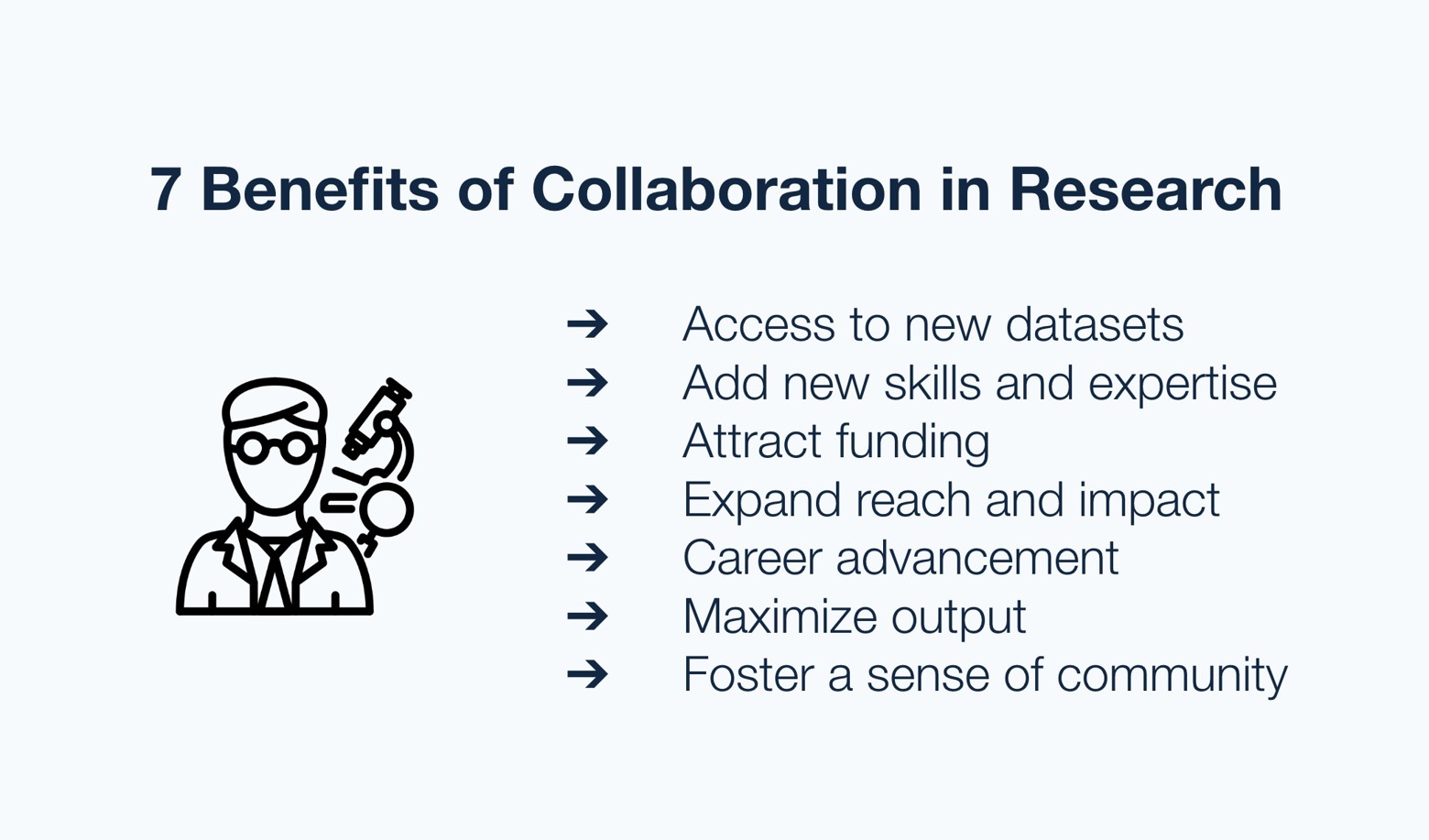7 Steps to Finding the Right Research Collaborator

Conferences are a great way to meet potential collaborators.
You’ve likely heard that “two heads are better than one.” This phrase rings true in a variety of settings, but especially in the context of scientific research.
It’s been proven repeatedly that cooperation is beneficial to research initiatives. Scientific collaboration has many advantages:
- It brings together a unique mixture of talents, cultures, and knowledge. This, in turn, can lead to more creative and impactful outcomes from research.
- It’s an effective way for individuals in the scientific community to build and maintain their careers (particularly for young researchers looking to grow their networks).
- It helps bridge the gap between varied fields (or geographic regions) of research.
During the Covid-19 pandemic, the extraordinary benefits of research collaboration were clearly demonstrated. As researchers worked together against a common enemy in the virus, those efforts led to accelerated solutions at a rate that is rarely seen in the scientific world.
Collaboration vs. Competition in the Research Community
Unfortunately, some barriers still exist to widespread research collaboration. The paradox between cooperation and competition in the scientific world means that researchers work in a tricky environment — one where their biggest competitors in publishing research are also their best potential collaborators for that same research.
In spite of these barriers, it’s vital that researchers don’t let the pressure to publish first get in the way of what’s really important: the actual progress of science.
How to Find a Great Research Collaborator
While we wish it was as easy as plugging some data into an automated algorithm that pairs you with the perfect person, the technology isn’t quite up to the task yet.
Research collaboration software can be a good place to start, but it still does a pretty bad job at matching researchers from a human interaction perspective — a factor that can make or break collaboration initiatives.
So, until technology improves, you’ll have to do a bit of extra work to find collaborators that complement you on both a professional and personal level. Here are seven steps to help you get started…
1. Determine Your Purpose for Collaborating

An important first step is to determine your purpose for collaborating.
Before you start reaching out, think about your goals for collaboration. Are you looking to build connections for career advancement? Do you want to gain extra awareness for your research? Do you need someone to help collect data or do field work? Or, are you trying to fill some other skill gap that’s required for your research?
Whatever the goal, thinking about how the collaboration will meet your needs will help you be strategic about who you contact and how they fit into your next steps.
2. Assess Your Skills & Your Gaps
Many researchers make the mistake of focusing only on what they need without defining what they can bring to the table. So, before you reach out to anyone, think about what you have to offer.
Your potential collaborators will have their own challenges. What can you provide that will help them? You’ll likely have to adjust your strategy for each individual you reach out to. Don’t shy away from directly asking them what their struggles are. It will help you suggest ways that you can work together for mutual benefit.
On a similar note, evaluate any skill gaps you may have (and be clear about how you think the other person’s skills could complement your own). Acknowledging your shortcomings can be uncomfortable, but it will lead to more effective collaborations in the long run.
It can also be helpful to work with people who do things differently from you or view the world from another perspective. Having diverse personalities in a collaboration can produce more interesting results (i.e. pairing a structured, hyper-organized person with a more free-spirited, big-picture thinker during a brainstorm session).
3. Reach Out to Your Current Network
Once you’ve got a clear picture of what you’re looking for and what you can bring to the table, the next step is to start reaching out. The “low-hanging fruit” (aka. your current network) is always the best place to start.
Send messages or post on social media, update your LinkedIn profile, talk to old professors/supervisors, reach out to past and current colleagues, and get in touch with any other professional or personal connections that may be of help. Ask your network to introduce you to potential collaborators if they know of anyone who would be a good fit.
Finally, think about the best methods to contact people. This will depend on what ways you feel most comfortable communicating as well as the preferences/culture of each individual you contact. Scanning a person’s social media can be a great way to get an idea of how they communicate (and what they might be like to work with) before you reach out.
4. Take Steps to Grow Your Network & Presence
By reaching out to your current network, you’ll likely have already gained a few new contacts via personal introductions. Here are a few other ways to help grow your network:
- Practice introducing yourself - Prepare a few lines that explain who you are, your area of experience, and any of your major achievements. This can be used in writing (like emails and LinkedIn) or when speaking to new connections (at conferences and networking events).
- Search online collaboration platforms - If you’re looking for fresh faces outside of your network, take a peek at collaboration platforms like Collaboratory to help you build a list of potential research collaborators. Getting your profile up on sites like this has the added benefit of increasing the chances that someone else reaches out to you first.
- Hit the research conference circuit - Conferences are great networking opportunities. Attending sessions in your area of interest is a built-in, conversation starter to get you talking with other people in your field. Be sure to check out our tips to prepare for an academic conference before you go.
- Write something and publish it - Whether it’s a blog post or a journal article, publishing something online helps increase your visibility to other researchers who are doing similar work. Journal articles can help potential collaborators in the same field find you. While “lessons-learned” or opinion-based blog articles have the benefit of easy shareability and a potentially wider reach.
- Get involved in a professional organization - Almost every field of science has a professional organization that works to advance the research and careers of those working in it. So, find the organization(s) that suit you best and take full advantage of what they have to offer (i.e. networking events, collaboration databases, research grants, etc…).
5. Don’t be Afraid to Make the First Move
If you’ve found someone who you think could be a good collaborator, get the conversation started. Do some research on the person first to help personalize your approach (and to figure out the best way to contact them).
Generally, email is considered to be the most professional method of communication. So, if you’re not speaking in-person already, start the conversation there.
Keep your first email formal. Highlight what you know about their work, introduce yourself, and be clear about what you are offering. Once they’ve responded, you can plan next steps — whether that’s a video call or a meetup at an event you’re both attending.
If they don’t respond right away, don’t be disheartened. Send a follow-up after one or two weeks. Acknowledge that you realize they are likely busy and ask them if there would be a better time to contact them about a potential research collaboration.
6. Test the Waters & Set Expectations
When you’re in the early stages of a collaboration conversation, start small. Get together with the person or group. Throw some ideas around and see how you interact. Even if your research focus fits perfectly, the collaboration won’t succeed if you don’t work well together.
As the conversation continues, set expectations before any official collaboration begins. This includes outlining things like percentages of involvement, important deadlines, expected response times, conflict management strategies, and how each person will be credited.
Open and honest communication, along with opportunities for discussion and disagreement, are key factors in successful research collaboration.
7. Lay the Foundation for Future Research Collaboration
If the fit is right and you start collaborating with someone, it’s never too early to start thinking about what comes next. Whether you continue collaboration with the same person on future projects, or gain an introduction to other potential research collaborators, keep your eyes open for opportunities.
More Tools to Help You Find Research Collaborators…
In addition to the steps we’ve outlined, you can use these additional resources to help you find the right research collaborator:
Watch this webinar by Enago and AcademicLabs. It includes a discussion on research collaboration as well as some suggested tools.
Browse the Web of Science to search authors who are writing (and citing) the hottest papers on your topic. They even provide a handy guide on how to use the Web of Science for finding potential research collaborators.
Visit research networking forums like ResearchGate and Google Scholar. They’re great places to demonstrate your expertise and evaluate the experience of others.


